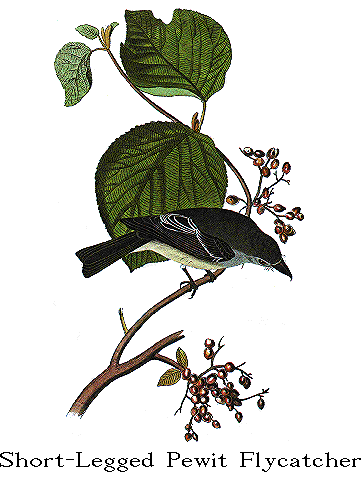Birds of America
By John James Audubon, F. R. SS. L. & E.
VOLUME I.



Family
Genus

SHORT-LEGGED PEWIT FLYCATCHER.
[Western Wood-Pewee.]
MUSCICAPA PHOEBE, lath.
[Contopus sordidulus.]

PLATE LXI.--MALE.
I found this species plentiful on the coast of Labrador, where, for awhile,
I thought it so nearly allied to our Common Pewee Flycatcher, as almost to
render me indifferent to its notes, movements, and nidification, all of which,
however, I at length discovered to differ considerably, especially the latter.
On this particular subject, on which I have already said so much, I may here
repeat, that birds of the same species may in some localities form nests
extremely different from those constructed by them in others. Indeed,
accustomed as I have been to this for a considerable number of years, I thought
it in no way remarkable to find the nest of what I then considered as our Common
Pewee placed in a bush, instead of being placed against a rock or under a shed,
for I thought the difference less than that presented by the nidification of our
Common Crow Blackbird, which in Louisiana deposits its eggs in the hollow of a
tree, while in Pennsylvania and other districts, it constructs as regular a nest
as our Turdus migratorius. It was not long, however, before I discovered
material differences in the deportment, habits, and voice of this Flycatcher and
the Pewee; the larger size of the latter of which rendered me confident that I
could not be mistaken, as I frequently saw both birds in the course of my daily
rambles.
Although it is very difficult to distinguish preserved skins of our many
plain-coloured Flycatchers, yet to one who has traversed the woods, and listened
to their voices, there is little difficulty in recognising the sounds of any of
them, for the cries of all are different, and may be known with certainty,
however alike they may seem to one who has seldom heard them. The notes of the
present species differ from those of the Common Pewee, being as it were hoarse
or harsh. It never jerks up its tail, as is the common habit of that species,
and in this respect differs from all our Flycatchers. Again, this Flycatcher,
instead of standing on an eminence for an hour at a time, as the Pewee does,
pouring forth its ditty, is continually in motion; and never alights on rocks or
the higher parts of trees, but keeps on low bushes at all times. Its flight too
is different, for instead of launching upward after its prey, it flies low,
proceeding immediately over the tops of the plants, from which it sweeps the
insects before they are aware of the presence or purpose of the little
depredator that skippingly passes over them. After this, it betakes itself to
the tallest and rankest weed of the open space, whether a narrow valley, or the
environs of one of those small ponds so abundant in Labrador, and which in
summer displays a most luxuriant growth of aquatic plants. The Common Pewee, on
the contrary, which also breeds in that country, frequents rocks and the tallest
fir trees.
Whilst in Labrador, I examined several nests of the Short-legged Pewee, all
of which were placed on low bushes, and almost as bulky as those of the Pipiry
Flycatcher, or about double the size of that of our Common Pewee. They were all
formed of a quantity of such dry mosses as are commonly found hanging from the
stems of all low bushes in the vicinity of the places in which this species
breeds, together with feathers of the Eider Duck and Willow Grouse. They were
suspended between the forks of two twigs, and in this respect resembled the
nests of the Orchard Oriole. The eggs varied from five to seven, measured
six-eighths of an inch in length, four-eighths in breadth, and instead of being
pure white, like those of the Pewee, were spotted nearly all over with minute
brown specks on a light bluish ground; On the 21st of July I saw the first young
on wing, and as at that time they were fully fledged, I thought that even in
that cold region, this species may perhaps breed twice in the season.
The migratory movements of this bird are very peculiar. I feel almost
confident that none pass southward over our Atlantic districts, and it would
appear that they must advance along the eastern base of the Rocky Mountains, as
I have not heard of their having been found to the westward of that range.
TYRANNULA RICHARDSONII, SWAINSON'S SHORT-LEGGED PEWIT,
Swains. and Rich. F. Bor. Amer., vol. ii. p. 146.
SHORT-LEGGED PEWEE FLYCATCHER, Muscicapa Richardsonii,
Aud. Orn. Biog. vol. v. p. 299.
Second quill longest, third almost equal, first and fourth nearly equal;
tail slightly emarginate; upper parts dark olivaceous brown, the head darker,
wings and tail blackish-brown, secondary coverts tipped with brownish-white, and
secondary quills margined with the same; outer edges of lateral tail-feathers
pale brownish-grey; fore part of neck, breast, and sides light dusky grey,
tinged with olive; abdomen pale dull yellow; lower tail-coverts brownish-grey,
margined with yellowish-white.
Male, 6 9/12, wing, 3 1/4.
Columbia river. Fur Countries. Labrador. Rare. Migratory.
HOBBLE BUSH.
VIBURNUM LANTANOIDES, Mich., Fl. Amer., vol. i. p. 179.
Pursch., Fl. Amer. Sept., vol. i. p. 202.--PETANDRIA MONOGYNIA, Linn.
This species, which grows in the woods, from Canada to Virginia, is
characterized by its large, suborbicular, subcordate, unequally serrate, acute
leaves, its dense cymes, and ovate berries, which are at first red, but
ultimately black.









